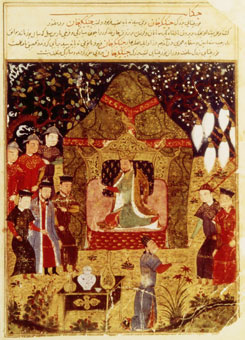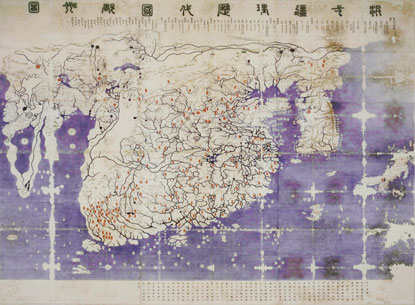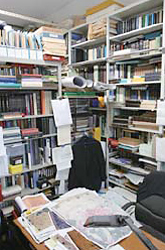Toward the Creation of a New Portrayal of World History
The Mongol Period as a Turning Point in World History
At the start of the 13th century a storm swept across Eurasia wreaking havoc. The storm raged on for over half a century. In its wake Eurasia and Africa were gradually united across both land and sea. The form of this landmass constituted an “Afro- Eurasian world,” and for the first time in world history, the world could be pictured as a single whole.
The idea has gained currency in Japan and overseas of seeing the 13th and 14th centuries, an era during which the Mongols occupied the center of the world stage and played the leading role, as an important turning point in world history and labeling the age as the “Mongol Period.” Fully cognizant of the preexisting Western conceptions of “geographical discoveries” and “the age of great discoveries,” I have argued that from the steppe, whose place in human history cannot be overlooked, the Mongol period once arose and that it preceded the Western age of discovery by over a century. This view may in some sense be termed a conception of world history that originated in Japan.
In short, prior to the commencement of the “globalization of the world” that took place on a worldwide scale as a result of the Western European foray onto the high seas, no one could deny that Eurasia and North Africa together with East Africa functioned as the main stage of human history. If the lengthy course of this history is termed the “history of Eurasia” or the “history of the Afro-Eurasian world,” one sees that the majority of the territory of this “old world” had been gradually drawn together either directly or indirectly due to the expansion of the Mongol empire. However we refer to it, it must be noted that the creation and operation of this “system” was absolutely unprecedented.

The Enthronement of Chingis Khan
( Jâmi‘ al-Tavârikh, Bibliothèque Nationale, Paris)
First, during the half-century long period following the age of the founder Chingis Khan in the early 13th century, much of Eurasia was amassed into what has come to be known as the Mongol empire an empire whose grip extended across the greatest landmass in human history. Then, following the age of the fifth khan, Khubilai, the sovereign state of the Great Yuan Ulus, officially the Great Yuan of the Great Mongol Ulus (Dai On Yeke Mongghul Ulus), ventured onto the high seas as a nation state and seized control of the trade and communications routes of the Indian Ocean. The result of this aggressive systemization across land and sea was a state of affairs that might be termed the “Eurasian communications sphere” or the “Afro- Asian communications sphere,” centered on the Mongols, who had thus formed a “world alliance of nations.” Western historians originally likened this to the “Pax Romana” and referred to it as the period as “Pax Tatarica” or “Pax Mongolica.” It cannot be denied that the regions of Asia, to say nothing of those of Europe, were being swept up at this time into the new state of affairs by the Mongols and that they were confronting a new age. The flowering of the Renaissance in Europe and the later revival of Mediterranean trade and rapid advances in sailing technology in the 14th century finally brought about the preconditions for Western Europe, led by Portugal and Spain, to advance abroad on the high seas.
I have researched the history of Eurasia, both east and west, and concentrated chiefly on the “Mongol period.” The pertinent written sources for such study are recorded in more than twenty different languages, and a vast number of archaeological material sources, artifacts, sites are extant. In recent years an accurate and complete portrait of this world has finally become visible. The significance of this new portrayal is as I have noted above. When viewing Afro- Eurasia of the “Mongol period” and the periods just prior and immediately after it, one cannot help but wonder how it was that world history had previously been recounted solely in terms centered on the West? Since the second half of the 19th century and the beginning of the 20th century, it has become necessary to fundamentally remake the portrayal of world history that had been created in the West.
The Pursuit of a Foundation for a Consciousness of the World
On further reflection, we might wish to consider what exactly this history of which we speak is. What really is the point of the study of history? What is it that those who are called historical researchers or historians are in fact pursuing? And what is it that they seek to recount? These questions, which have been posed since ancient times, have in recent years taken on a more pressing and poignant tone.
The post-Cold War world has followed the path of globalization and computerization at an unprecedented level of intensity. In spite of the trend towards growing unity and uniformity in various fields, such as economics, distribution, finance, transport, visual imagery, music, entertainment, fads, fashion and food, clearly negative aspects, such as war, terror, crime, AIDS, epidemics, BSE, and pollution of the atmosphere and the seas, are increasing on a world-wide scale. The many problems subsumed under the term “environmental issues” are classic examples.
The visions of the world or of world history created by theorists and historians of the past will be forsaken by a reality that catches and overtakes them or will require fundamental reconstruction. “Revisioning the modern” and similar projects are the least that can be done. To put it more bluntly, whether we like it or not, for us who live in the present day thinking on a planet-wide or global scale has become commonplace as a result of globalization and communications technology. Furthermore, when looking back from today’s standpoint, it is surely the case that many people will naturally wish to consider in which ways each and every period in the past operated on a global scale and take a broad second look at history using their modern perspective as a measuring stick.
It is clear that being a historical researcher who depends on original sources concerning a particular time period, region, or field, and also being a historian who paints a picture of history of each period from several angles is not an easy matter; however, many have devoted themselves to this task.

 Honil ganghi yeokdae gukdo ji do (Hon-kôji Temple, Shimabara)
Honil ganghi yeokdae gukdo ji do (Hon-kôji Temple, Shimabara)
Moreover, given the current conditions in which nearly all obstacles involving source materials, politics, and national boundaries have been eliminated, that which is truly required today is a portrayal of the course of history with a global scope, in other words, a factually based account of the whole human history.
Such a portrayal of history is indispensable in presenting a point of view based on a consciousness of the world irrespective of the past, present, or future. And, if this challenge can be met, I hope that it may serve as the foundation of shared human knowledge. At base, this enterprise must involve a joint effort to assemble shared human knowledge and overcome the differences of individuals, borders, and races. This is a difficult but necessary and meaningful challenge for the age in which we live today.

Masaaki Sugiyama
Born in 1952
Field of specialization: Inner Asian History
Completed doctoral program, Graduate School of Letters, Kyoto University
Professor, Graduate School of Letters, Kyoto University
With the improvement in the quality of historical research, it is possible to make a complete story of world history.
Prof. Sugiyama worked as an assistant professor for nine years at the Institute for Research in Humanities after he completed a doctoral program in Oriental History at the Graduate School of Letters, Kyoto University, in 1979. Prof. Sugiyama says, "Because I had a lot of time in my days as an assistant professor at the Institute for Research in Humanities, I was able to conduct field surveys of Europe and Eurasia, just before the Cold War between the East and the West ended. The surveys that I conducted during this period have greatly influenced my later study."
Prof. Sugiyama, who liked history when in high school, had doubts about the Eurocentric view of world history. By going beyond the framework of Eastern and Western civilizations, he has studied history from a Eurasian point of view, mainly the Mongolian era of the 13th and 14th centuries. His activities include giving lectures and being involved in the production of television programs to propose a new image of world history. His statement, “Japanese can take a general survey of world history from a neutral standpoint, without getting caught up in the Eurocentric viewpoint," illustrates his faith in his own research. Recently, he has been promoting a project to integrate the humanities and science with the Research Institute for Humanity and Nature of the National Institute for the Humanities, and dealing with environmental problems in the middle of Eurasia where historical research has not existed for more than 200 years.
Prof. Sugiyama proposes that "from the viewpoint of human development, students should learn the political history, concentrate on learning many languages, and study other areas beyond their own specialized fields.” In addition to Japanese students, foreign students from many various countries including Kazakhstan, the U.S.A., China, Mongolia, and Korea get together with Prof. Sugiyama every week to debate till late at night in order to improve their Persian proficiency.

